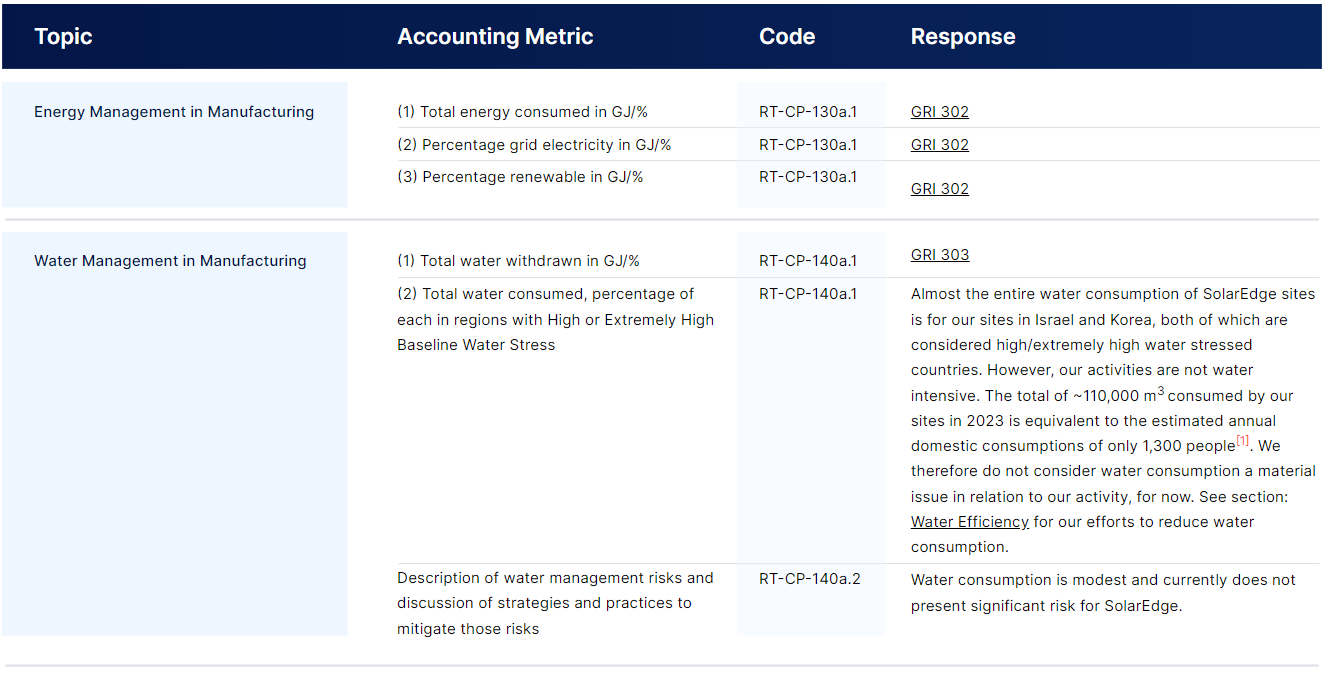SASB Disclosure
RT-CP-130a.1
RT-CP-140a.1
RT-CP-130a.1
Almost the entire water consumption of SolarEdge sites is for our sites in Israel and Korea, both of which are considered high/extremely high water stressed countries. However, our activities are not water intensive. The total of ~110,000 m3 consumed by our sites in 2023 is equivalent to the estimated annual domestic consumptions of only 1,300 people[1]. We therefore do not consider water consumption a material issue in relation to our activity, for now. See section: Water Efficiency for our efforts to reduce water consumption.
RT-CP-140a.2
RT-CP-140a.1
RR-ST-410a.2
RR-ST-440a.2
RR-ST-160a.2
RR-ST-410b.3
RR-ST-410b.4
RR-ST-410b.2
RR-ST-000.C
RR-ST-000.B
RR-ST-150a.2
RR-ST-410a.1
RR-ST-440a.1
RR-ST-160a.1
RR-ST-410b.1
RR-ST-000.A
RR-ST-150a.1
RT-CP-130a.1
Water consumption is modest and currently does not present significant risk for SolarEdge.
Not material for SolarEdge: only a very small portion of our global business involves the purchase and sale of solar panels. See section: Human Rights in China for more details.
Not material for SolarEdge – our Inverters and Optimizers do not generate material negative ecological impacts.
We use a small amount of antimony compounds at an estimated <0.1% of our total production.
Waste Management
Product End-of-Life,
This data is not currently available
Data not currently available
None
SolarEdge 2023 Annual Report on Form 10-K: p. 18, 22-23, 29-30
Not appliable to SolarEdge
None
This data is not currently available
2023 Performance Summary
2023 Performance Summary
GRI 306
GRI 303
GRI 302
GRI 302
GRI 302
Description of the management of environmental risks associated with the polysilicon supply chain
Total project development assets in $
Total capacity of completed solar energy systems in MW
Description of the management of risks associated with the use of critical materials
Total capacity of photovoltaic (PV) solar modules produced in MW
Materials Sourcing
Activity Metrics
Response
Code
(3) Percentage renewable in GJ/%
(2) Total water consumed, percentage of each in regions with High or Extremely High Baseline Water Stress
(2) Percentage grid electricity in GJ/%
Description of water management risks and discussion of strategies and practices to mitigate those risks
(1) Total water withdrawn in GJ/%
Description of risks and opportunities associated with energy policy and its impact on the integration of solar energy into existing energy infrastructure
Description of efforts in solar energy system project development to address community and ecological impacts
Percentage of products by revenue that contain IEC 62474 declarable substances, arsenic compounds, antimony compounds, or beryllium compounds
Description of approach and strategies to design products for high value recycling
Weight of end-of-life material recovered, percentage recycled
Number and aggregate quantity of reportable spills, quantity recovered
Description of risks associated with integration of solar energy into existing energy infrastructure and discussion of efforts to manage those risks
Number and duration of project delays related to ecological impacts
Percentage of products sold that are recyclable or reusable
Amount of hazardous waste generated, percentage recycled in MT/%
(1) Total energy consumed in GJ/%
Water Management in Manufacturing
Management of Energy Infrastructure Integration & Related Regulations
Ecological Impacts of Project Development
Product End-of-life Management
Hazardous Waste Management
Energy Management in Manufacturing
Accounting Metric
Topic
Sustainability Report 2023 /
SASB Disclosure
Join the SolarEdge Conversation
Contact our sustainability / ESG team
Contact us
How can we help you?
Based on the average water consumption of a resident of Israel, source: Mei-Avivim water corporation
[1]
Join the SolarEdge Conversation
Contact our sustainability / ESG team
Contact us
How can we help you?













